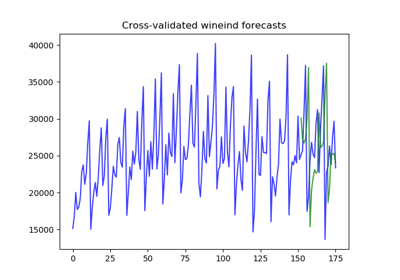pmdarima.model_selection.SlidingWindowForecastCV
- class pmdarima.model_selection.SlidingWindowForecastCV(h=1, step=1, window_size=None)[source][source]
Use a sliding window to perform cross validation
This approach to CV slides a window over the training samples while using several future samples as a test set. While similar to the
RollingForecastCV, it differs in that the train set does not grow, but rather shifts.- Parameters:
- hint, optional (default=1)
The forecasting horizon, or the number of steps into the future after the last training sample for the test set.
- stepint, optional (default=1)
The size of step taken between training folds.
- window_sizeint or None, optional (default=None)
The size of the rolling window to use. If None, a rolling window of size n_samples // 5 will be used.
- Attributes:
horizonThe forecast horizon for the cross-validator
See also
References
Examples
With a step size of one and a forecasting horizon of one, the training size will grow by 1 for each step, and the test index will be 1 + the last training index. Notice the sliding window also adjusts where the training sample begins for each fold:
>>> import pmdarima as pm >>> from pmdarima.model_selection import SlidingWindowForecastCV >>> wineind = pm.datasets.load_wineind() >>> cv = SlidingWindowForecastCV() >>> cv_generator = cv.split(wineind) >>> next(cv_generator) (array([ 0, 1, 2, 3, 4, 5, 6, 7, 8, 9, 10, 11, 12, 13, 14, 15, 16, 17, 18, 19, 20, 21, 22, 23, 24, 25, 26, 27, 28, 29, 30, 31, 32, 33, 34]), array([35])) >>> next(cv_generator) (array([ 1, 2, 3, 4, 5, 6, 7, 8, 9, 10, 11, 12, 13, 14, 15, 16, 17, 18, 19, 20, 21, 22, 23, 24, 25, 26, 27, 28, 29, 30, 31, 32, 33, 34, 35]), array([36]))
With a step size of 4, a forecasting horizon of 6, and a window size of 12, the training size will grow by 4 for each step, and the test index will 6 + the last index in the training fold:
>>> cv = SlidingWindowForecastCV(step=4, h=6, window_size=12) >>> cv_generator = cv.split(wineind) >>> next(cv_generator) (array([ 0, 1, 2, 3, 4, 5, 6, 7, 8, 9, 10, 11]), array([12, 13, 14, 15, 16, 17])) >>> next(cv_generator) (array([ 4, 5, 6, 7, 8, 9, 10, 11, 12, 13, 14, 15]), array([16, 17, 18, 19, 20, 21]))
Methods
get_metadata_routing()Get metadata routing of this object.
get_params([deep])Get parameters for this estimator.
set_params(**params)Set the parameters of this estimator.
split(y[, X])Generate indices to split data into training and test sets

